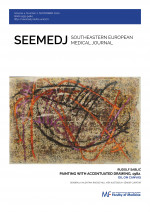Early Vital Indicators of Newborns Born After Medically Assisted Reproduction
DOI:
https://doi.org/10.26332/seemedj.v4i2.137Keywords:
high-risk pregnancies; , in vitro fertilization; , natural conception;, prematurity; , low birth weightAbstract
Aim: In this case-control study we wanted to compare the perinatal outcome of naturally conceived newborns to those born after in vitro fertilization (IVF).
Methods: At the University Hospital Centre Osijek, in the period from January 2014 to December 2016, we analysed 120 in vitro fertilization pregnancies and compared to 120 natural conception pregnancies. Characteristics of mothers, birth method, perinatal outcome, and vital characteristics of newborns were analysed.
Results: IVF-ET pregnancies included 70.0% singleton pregnancies, 28.3% twin and 1.7% triplet pregnancies, while all naturally conceived pregnancies were singletons. When pregnancies were compared between IVF-ET and naturally conceived groups, the following characteristics of mothers were established: age 34.83 (5.8):30.39 (3.9); previous pregnancy 13.3%:56.7%; complications in pregnancy 50.0%:25.0%; Caesarean section (CS) 69.2%:35.8%. All of these were statistically significant (p < 0.001). Comparison of newborns between those two groups established the following: prematurity 39.5% vs. 12.7%; lowest BW 2,114 vs. 3,000 grams; lowest GA 22.29 vs. 28.71 weeks. In the IVF-ET group, 5.7% of newborns had a gestational age of 22-25 weeks, but there were no newborns of that gestational age among the naturally conceived newborns. These were also statistically significant differences (p < 0.001). Apgar score was 10 for both groups, but the difference was in the interquartile range, the values of which were lower in the IVF-ET group.
Conclusion: In vitro fertilization pregnancies are high risk due to the characteristics of both the mother and the infant and, as such, require special attention and care.
Downloads
Published
Issue
Section
License
Copyright (c) 2025 Southeastern European Medical Journal

This work is licensed under a Creative Commons Attribution-NonCommercial-NoDerivatives 4.0 International License.



